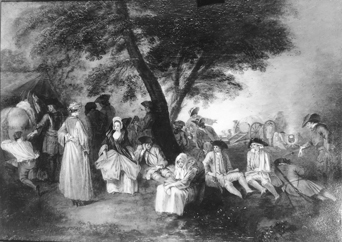
- Home Page
- Accepted
Paintings & Copies - Doubtful
Attributions - Doubtful Textual References
- Alternative
Titles - Collectors &
Museums - Bibliography
- Search Abecedario
- Watteau &
His Circle
L’Alte (copy 1)
Entered August 2014; revised January 2017
Whereabouts unknown
Oil on panel
39 x 47 cm
PROVENANCE
Zurich, Konta collection, c. 1977
EXHIBITIONS
Paris, Musée de la monnaie, Pèlerinage (1977), cat. 174 (as French School 18th Century, Alte, lent by a Swiss private collection).
SELECT BIBLIOGRAPHY
Washington, Paris, and Berlin, Watteau 1684-1721 (1984), under cat. P5.
REMARKS
This copy of L’Alte is in the same direction and relatively the same size as the original Watteau painting. It has as a pendant a copy of Le Défilé.
L’Alte (copy 2)
Entered August 2014

Whereabouts unknown
Oil on panel
30.5 x 40.6 cm
ALTERNATIVE TITLES
An Encampment
PROVENANCE
London, collection of Sir Frank Newson-Smith (1879-1971); his sale, London, Christie’s, January 26, 1951, lot 135: “A. WATTEAU . . . AN ENCAMPMENT with ladies and soldiers near a tree—on panel—12in. by 16in.” Sold for £84 to Thorburn according to a photograph in the Witt Library.
SELECT BIBLIOGRAPHY
Washington, Paris, and Berlin, Watteau 1684-1721 (1984), under cat. P5.
REMARKS
Sir Frank Newson-Smith’s picture may have originally been owned by his father, Sir Henry Newson-Smith (1854-1898), a chartered accountant and theatrical entrepreneur who had a great interest in art.
L’Alte (copy 3)
Entered August 2014

Whereabouts unknown
(?) Oil on panel
31 x 40 cm
PROVENANCE
Paris, collection of Baron Ernest Sellière (1866-1955).
SELECT BIBLIOGRAPHY
Reau, “Watteau” (1928), cat. 45.
Washington, Paris, and Berlin, Watteau 1684-1721 (1984), under cat. P5.
REMARKS
In the early years of the twentieth century, when Lord Leconfield’s painting was essentially unknown to most critics, especially those outside of England, Réau and others thought that Baron Sellières’ version of L’Alte was Watteau’s original work. All this changed in the postwar years when the Leconfield painting became better known and was accepted. Sellière’s painting fell from sight.